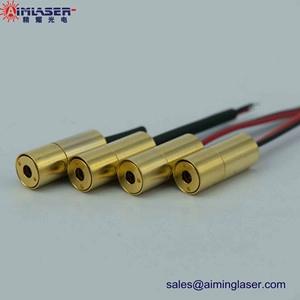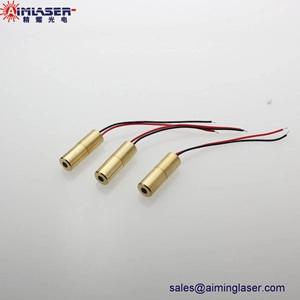In the laser diode market, red and blue semiconductor diodes are mature and widely used in display devices. Although green semiconductor laser technology has made some progress recently, it still can't meet the requirements of laser display, and there is still a long way to go before its commercial application in batches. In  addition to directly generating green light from semiconductor lasers, the most commonly used and mature technology to obtain green light at present is to use nonlinear optical crystals to double the frequency of 1064 nm infrared light generated by all-solid-state lasers to 532 nm green light. At present, the development of green laser for laser display mainly focuses on the structure of intracavity frequency doubling. The intracavity frequency-doubled green laser usually includes a laser crystal used to generate 1064 nm infrared laser and a nonlinear optical crystal used to generate green light. For laser crystal, (Nd:YVO4) is considered as the best gain medium because of its high gain, polarized output and high absorption coefficient at the pump wavelength of 808 nm. As for nonlinear crystals, KTP or LBO are two kinds of nonlinear crystals that are used in DPSS green lasers at home and abroad. Both have certain defects, and the price is several times higher. Therefore, the laser display industry urgently needs compact, low-cost, high-efficiency and high-output green laser.
addition to directly generating green light from semiconductor lasers, the most commonly used and mature technology to obtain green light at present is to use nonlinear optical crystals to double the frequency of 1064 nm infrared light generated by all-solid-state lasers to 532 nm green light. At present, the development of green laser for laser display mainly focuses on the structure of intracavity frequency doubling. The intracavity frequency-doubled green laser usually includes a laser crystal used to generate 1064 nm infrared laser and a nonlinear optical crystal used to generate green light. For laser crystal, (Nd:YVO4) is considered as the best gain medium because of its high gain, polarized output and high absorption coefficient at the pump wavelength of 808 nm. As for nonlinear crystals, KTP or LBO are two kinds of nonlinear crystals that are used in DPSS green lasers at home and abroad. Both have certain defects, and the price is several times higher. Therefore, the laser display industry urgently needs compact, low-cost, high-efficiency and high-output green laser.
Like many phase-sensitive nonlinear frequency conversion processes, the high-efficiency frequency doubling process not only requires the material to have high second-order nonlinear polarizability, but also keeps a fixed phase relationship between the phases of the interacting light waves, so as to ensure that the energy of the incident light waves can be converted into frequency doubled waves in one direction. Quasi-phase matching is not strictly limited by polarization direction and wave vector direction. It can  achieve phase matching only by selecting the appropriate polarization period, so it has the following advantages: First, the maximum nonlinear coefficient of the crystal can be used. Although QPM is not perfect in phase matching, it can take advantage of the high nonlinear coefficient that BPM can't achieve because it has no specific limitation on nonlinear coefficient. Second, there is no walk-off effect. QPM is not affected by crystal birefringence, so long as the interacting light waves propagate along the same crystal axis, there can be no walk-off angle problem. If there is no walk-off effect, the fundamental wave and harmonic wave can always interact in a longer nonlinear crystal, thus obtaining a higher conversion efficiency. Thirdly, wavelength conversion can be realized in the whole light transmission range of the crystal. QPM guides the energy conversion through periodic polarization structure, and the periodic structure can be artificially designed according to the refractive index dispersion and the corresponding wavelength conversion process, without special temperature and angle requirements, so it can cover the whole transparent band of the crystal. Because QPM technology broadens the application range of nonlinear crystals and greatly improves the nonlinear conversion efficiency, it has become a research hotspot in the fields of solid-state lasers and optical communication.
achieve phase matching only by selecting the appropriate polarization period, so it has the following advantages: First, the maximum nonlinear coefficient of the crystal can be used. Although QPM is not perfect in phase matching, it can take advantage of the high nonlinear coefficient that BPM can't achieve because it has no specific limitation on nonlinear coefficient. Second, there is no walk-off effect. QPM is not affected by crystal birefringence, so long as the interacting light waves propagate along the same crystal axis, there can be no walk-off angle problem. If there is no walk-off effect, the fundamental wave and harmonic wave can always interact in a longer nonlinear crystal, thus obtaining a higher conversion efficiency. Thirdly, wavelength conversion can be realized in the whole light transmission range of the crystal. QPM guides the energy conversion through periodic polarization structure, and the periodic structure can be artificially designed according to the refractive index dispersion and the corresponding wavelength conversion process, without special temperature and angle requirements, so it can cover the whole transparent band of the crystal. Because QPM technology broadens the application range of nonlinear crystals and greatly improves the nonlinear conversion efficiency, it has become a research hotspot in the fields of solid-state lasers and optical communication.
The green light module is a single element without adjustment, and its internal structure is that Nd:YVO4 crystal and MgO:PPLN crystal are packaged on the silicon substrate by a special process, with a certain length of air space between them. Different from the traditional plano-concave cavity, the green module uses a plano-planar cavity structure. This structure first simplifies a concave mirror, and at the same time shortens the length of the whole laser cavity, which reduces both the volume and the production cost. It is not only small in size and high in efficiency, but also can greatly simplify the packaging of subsequent lasers. The excellent performance and easy packaging of the miniature green laser are very suitable for laser display, especially for portable laser projectors. By increasing the power of 808 nm pump diode laser and optimizing the mGreen module, it is expected to get higher green output.